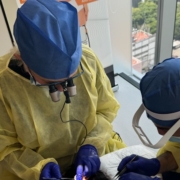Advancements in FUE Hair Transplants: How It Compares to Other Methods
Advancements in FUE Hair Transplants: How It Compares to Other Methods

Dr Kelemen the founder of Hair 4 Life Medical
What is FUE?
Follicular Unit Extraction (FUE) is a minimally invasive hair transplant technique where individual hair follicles are extracted from a donor area (typically the back of the head) and implanted into thinning or balding areas. Unlike traditional strip harvesting methods, FUE does not require a large incision, making it a preferred choice for those looking for a less invasive procedure with minimal scarring.Advantages of FUE
- Minimally Invasive: No large incisions or stitches are required, making recovery quicker and more comfortable.
- Natural-Looking Results: Individual follicle placement allows for a more natural hairline and density.
- Less Scarring: Unlike FUT, which leaves a linear scar, FUE results in tiny, nearly invisible puncture marks.
- Faster Recovery Time: Most patients can resume normal activities within a week.
How FUE Has Advanced
Recent advancements have significantly improved the efficiency and success rates of FUE hair transplants:1. Precision Handheld Devices
Handheld-assisted FUE enhances accuracy, ensuring consistent follicle extraction and placement. Advanced devices such as WAW, Ugraft, and Trivellini provide improved control, reducing trauma and increasing graft survival rates. These state-of-the-art tools allow for greater precision, minimizing follicular damage and ensuring optimal implantation.2. Importance of Punch Size
The size of the micro-punch used in FUE plays a crucial role in the procedure’s success. Smaller punches (typically 0.7-0.9mm) reduce scarring and trauma while preserving the donor area’s appearance. However, larger punches may be used for thicker grafts, balancing precision with efficiency. The right punch size ensures a better graft survival rate and maintains the overall aesthetics of both donor and recipient areas.3. Improved Extraction Tools
Modern micro-punch devices minimize trauma to the scalp, promoting faster healing and higher graft survival rates. Automated and motorized extraction tools allow for more efficient harvesting, reducing procedure time while maintaining high precision.4. Advanced Implantation Techniques
Some clinics use improved implanter pens to enhance follicle placement, ensuring a higher density and a more natural hairline. The ability to control the angle, depth, and direction of each implanted follicle significantly improves results.FUE vs. FUT: Key Differences
While FUE and FUT (Follicular Unit Transplantation) both involve transplanting hair follicles, they differ significantly in method and patient experience:| Factor | FUE | FUT |
|---|---|---|
| Scarring | Tiny, nearly invisible scars | Linear scar at donor site |
| Healing Time | Faster recovery (a few days to a week) | Longer recovery due to stitches |
| Procedure Type | Individual follicle extraction | Strip of scalp removed and dissected |
| Natural Appearance | High flexibility in hairline design | Slightly less natural in some cases |
| Cost | Generally more expensive | Typically less expensive |
How FUE Compares to Non-Surgical Options
For those hesitant about surgery, non-surgical hair restoration options exist, including:1. Medications (Minoxidil & Finasteride)
- Minoxidil (Rogaine) and Finasteride (Propecia) are FDA-approved treatments that help slow hair loss and promote hair regrowth.
- Require consistent, long-term use to maintain results.
- Best suited for early-stage hair loss rather than advanced balding.
2. Low-Level Laser Therapy (LLLT)
- Uses light energy to stimulate hair follicles.
- Non-invasive, but effectiveness varies among individuals.
- Works best in combination with other treatments.
3. Scalp Micropigmentation (SMP)
- A cosmetic procedure that creates the illusion of fuller hair.
- Involves applying pigment to the scalp to mimic hair follicles.
- Does not restore actual hair, but improves appearance.
Who is the Best Candidate for FUE?
FUE is suitable for a wide range of patients, including:- Individuals with mild to moderate hair loss.
- Those who prefer short hairstyles (since there’s no linear scarring).
- Athletes and active individuals who need a quicker recovery time.
- People looking for a more natural hairline.
- Patients who have had a previous FUT procedure and want additional coverage.
Post-Procedure Care and Recovery
To ensure the best results after an FUE hair transplant, patients should follow these key aftercare steps:Immediate Post-Op Care (First 48 Hours)
- Avoid touching the implanted grafts to prevent displacement.
- Keep the scalp clean and follow prescribed washing techniques.
- Refrain from intense physical activity that may cause sweating.
First Week
- Sleep with the head elevated to reduce swelling.
- Avoid direct sun exposure to prevent scalp irritation.
- Follow the clinic’s recommended medication routine to aid healing.
Long-Term Maintenance
- Avoid harsh chemical treatments for a few months post-surgery.
- Use mild shampoos to maintain scalp health.
- Consider maintenance treatments like PRP (Platelet-Rich Plasma) to enhance growth.













